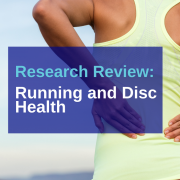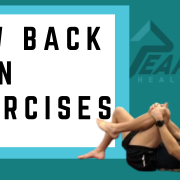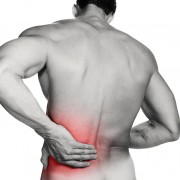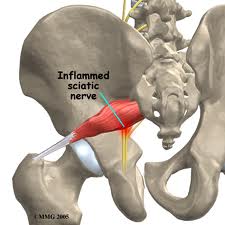Is Running BAD for your discs?
/in Low Back Pain, Low back Sports Injury, running injury, Uncategorized/by adminRunning and Your Spine: A New Look at Intervertebral Disc Health
There’s a common myth that running is bad for your back. But a new systematic review published in Sports Health tells a different story. This review combined 13 studies with 632 participants to investigate how running affects the health of intervertebral discs—the cushions between the vertebrae in your spine.
How Running Affects Your Spine
The review looked at two types of studies: some measured how running affected spinal height, while others used MRI to observe changes in disc composition. Here’s what the research found:
- Temporary Compression: Running causes temporary compression of the discs. This means that during a run, discs lose some water content and slightly shrink in height.
- Supercompensation Between Runs: After the run, your discs supercompensate by drawing water and glycosaminoglycans back in. These are important for keeping your discs hydrated and healthy. Over time, this process can actually improve disc health.
- Stronger, Healthier Discs: Habitual runners were found to have healthier and stronger discs than non-runners. So rather than damaging your spine, regular running appears to build resilience in your intervertebral discs.
Takeaways for Runners
This study is great news for runners and those hesitant to start due to back pain concerns. Here’s what you should know:
- Running is Safe for Your Back: The temporary disc compression during a run is completely normal and healthy. The key is the recovery between runs, where your body replenishes lost fluids and nutrients.
- Regular Running Builds Stronger Discs: Over time, the cycles of compression and supercompensation make your discs more resilient, reducing the risk of spinal issues.
- No Need to Fear Running: If you’ve been avoiding running due to fears of back injury, this study shows that running is not only safe but can actively improve your spinal health.
Incorporating regular runs into your routine can be a powerful way to maintain a healthy back. So, lace up those running shoes and start reaping the benefits for your spine!
Reference: Shu D, Dai S, Wang J, Meng F, Zhang C, Zhao Z. Impact of Running Exercise on Intervertebral Disc: A Systematic Review. Sports Health. 2024;0(0). doi:10.1177/19417381231221125
Low Back Pain Exercises
/in Back Pain Prevention, Low Back Pain, Low back Sports Injury/by Dr. Travis RoseMany people experience low back pain each year. Because the low back is a complex structure of joints, discs, ligaments, and muscles, the source of pain can be tricky to determine. Low back pain exercises are a must to help with the healing process and decrease your risk for a future injury.
Starting patients off with low back pain exercises, we like to address the back and hip tissue tightness, and mobility. In most cases of low back pain, the muscles of the back and hip develop trigger points. Trigger points are focal areas of hypersensitive fibers that cause local pain and refer pain. Performing low back pain exercises that target these tight spots can have significant effect at decreasing symptoms.
Here are our favorite low back pain exercises to help address tight, sore muscles in the back and hip.
Low Back Pain Exercises: Self Massage Technique
A massage ball to the lower back can be very effective at loosening your the lower back muscles. We like lacrosse balls as they are very firm and easily press into the low back muscles. Some people with smaller or thin body types may find the lacrosse ball to be too uncomfortable. Tennis ball, or racquet ball may work better.
Here is a nice video demonstration on how to perform lower back self massage.
Gluteal Self Massage
The second of the low back pain exercises we like to prescribe is self massage for the gluteal muscles. Again we like a lacrosse ball as it gets deep into the dense hip musculature. Try this one out on the wall. You can easily control the pressure from the ball and access different angles into the muscles easily. This exercise is also excellent in managing Iliotibial Band Syndrome.
Child’s Pose
An easy, but effective exercise to help with low back pain, stiffness, and tightness. This one of the more gentle low back pain exercises. It simultaneously stretches the low back muscles, while decompressing the low back joints and discs. Our video shows how to perform Child’s pose on multiple directions.
Lower Back Pain Decompression Exercise
Many people have heard of inversion tables to help take pressure of the low back. They are absolutely effective for many types of low back pain but they are expensive and they take up a lot of room. The decompression stretch below, utilizes a Swiss ball to provide a fulcrum which helps take pressure off the lumbar spine. You must be very relaxed when performing this exercise. You should not experience any pain with it at all
Low back pain exercises are a must in any treatment protocol for the low back. We start patients with exercises on the first day of treatment for the best outcomes. If you are in need of an evaluation and treatment, please schedule with us today! We are conveniently located in Mission Valley, San Diego near the neighborhoods of La Jolla, Carmel Valley, Mission Hills, Hillcrest, and Bird Rock.
Drs Travis and Kevin Rose are sports chiropractors in San Diego, California. They treat a wide range of injuries and have helped thousands of patients get back to their potential. Athletes themselves, they understand the importance of recovering from injury and returning to sport.
Different Types of Low Back Pain
/in Low Back Pain, Low back Sports Injury, Sports Injury/by adminCommon Causes of Low Back Pain
Low back pain is a very common issue experienced by the the general population at some point in life. Estimates vary but on average, about 38% of the general population experience low back pain in a year period.(2) Low back injury symptoms include: localized soreness, stiffness, and pain, radiating pain (pain into lower extremity), and possibly tingling and numbness into the lower extremity. The focus of this post will look at the common low back conditions we treat at our Mission Valley office.
First and foremost, we recommend seeking professional help from a certified sports chiropractor to correctly diagnose the low back injury. At our San Diego based sports injury clinic, we have seen many joint and disc injuries previously diagnosed as a “muscle strain” by a different provider. Simple diagnoses do patients no favors and will likely cause further harm!
Disc Injury
Let’s start by discussing what I would consider the most time intensive injury to resolve. Disc injuries have the following characteristics: occur in younger people (20-40 year old), common in athletes, associated with a memorable mechanism of injury (squatted and felt a “pop” in back), recurring back injury, worse with bending forward, muscle spasming, pain in the back with cough/sneeze/bowel movement, may have radiating pain (sciatica), and may have numbness/tingling in the lower extremities.
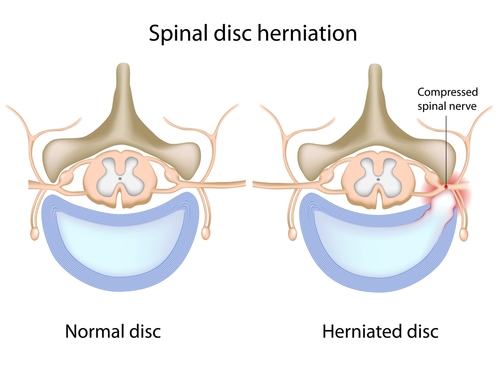 Joint pain
Joint pain
Lower back joint pain is characterized by the following: occurs in middle aged to older individuals (40-65+) with no mechanism of injury (gradually worsened) or younger people with a mechanism of injury (football player tackled in low back), worse when bending backward, sharp localized pain in low back, muscle spasming, possible pain into buttocks/thigh. The image below shows healthy low back joints. They can be injured with hyper extension or excessive bending through the spine
 Piriformis Syndrome
Piriformis Syndrome
Piriformis syndrome may be from acute spasming of the piriformis muscle (muscle runs from the tail bone to the outer hip) or from chronic tightening of the muscle. It is characterized by: pain in the buttocks, single sided sciatic symptoms, worse with sitting, no low back pain, worse with stretching hamstrings, and painful “knots” in the gluteal muscles/piriformis muscle. It is often misdiagnosed as a back related issue due to the symptoms of pain traveling down the leg. Check out our more thorough blog posts on piriformis syndrome found here: Piriformis Syndrome: Overview and Causes, Piriformis Syndrome Part II- Evaluation, and Piriformis Syndrome Part III- Treatment.
Low Back Muscle Strain
Please reread disc and joint causes of back pain. Both cause low back muscle spasming or muscles “locking up”. This is why doctors not certified to treat sport injuries diagnosis many low back injuries as a muscle strains. Technically they are not wrong because low back muscles are usually strained or spasmed when the deep structures (disc/joint) are injured. If you see a provider and they do not perform an evaluation including range of motion, orthopedic/neurological testing, and palpating (physically touching your back), get a second opinion. Once more serious conditions are ruled out, low back muscle strains are usually: local to the low back, muscle is sore/tight to touch, usually injured due to quick movements, and back muscles are often weak.
Special Types of Low Back Pain
Athletes with low back pain, especially in particular types of sports that involve repeated bending through the spine, may develop significant low back pain. Small fractures or stress reactions can occur to the pars interarticularis; a small portion of the vertebrea that when fracture can cause spondylolisthesis. Other injuries can involve the disc herniating into the end plate of the vertebral body of the low back. These types of injuries are confirmed with imaging (x-ray, MRI) but can be considered as a working diagnosis based on a thorough history and physical exam. If you have a sport related low back pain, please get evaluated by one of our Mission Valley sports chiropractors.
Treatment
In a recent review article discussing conservative management of low back pain, several methods are described as primary treatment choices for acute and chronic low back pain. For acute low back pain, chronic low back pain, and chronic low back pain with leg pain, a trial of spinal manipulative therapy with supplementary treatments such as exercise, massage, and patient education is recommended.(1) Specific types of exercises are prescribed based on the practitioner’s experience and patient’s tolerance. In other words, each person with low back pain may receive different exercises based on their presenting symptoms. Decreased pain and symptoms we found after short term (1-3 months) and long term (6-12 months) follow ups.
Initial treatment for low back pain is recommended between 4-8 visits over a 4 week period. (1)
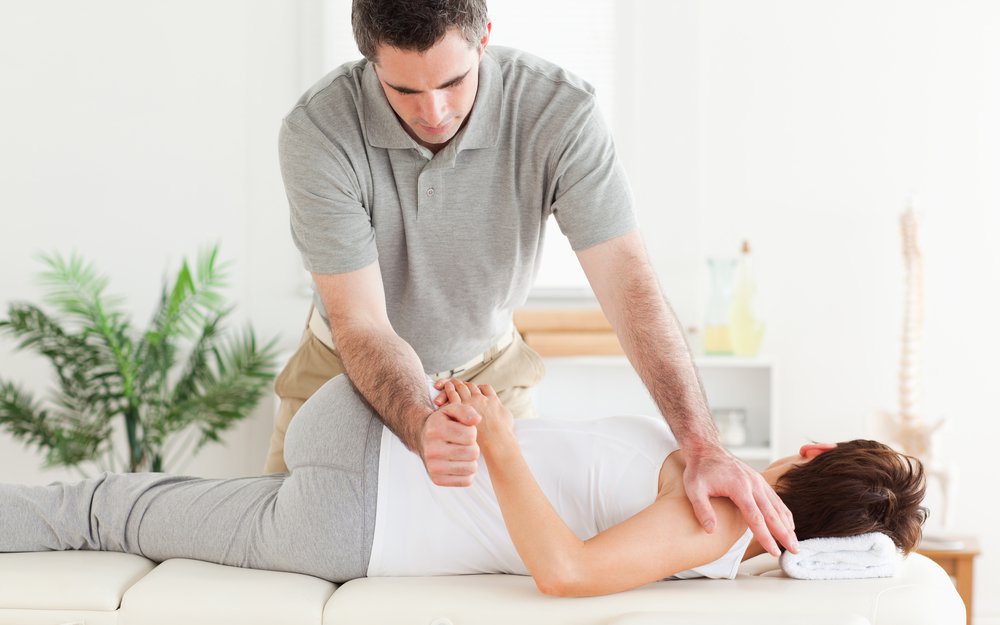
At our office in Mission Valley, we customize treatment plans for each and every low back pain patient we see. For example, if a patient has a diagnosed disc injury in their back, extension based exercises for the low back may offer significant relief for one patient, yet cause terrible pain in the next patient with the exact diagnosis. Evaluation in person by a certified sports chiropractor will be able to determine the correct treatment approach. We utilize the latest techniques including spinal manipulative therapy, Active Release Technique, Graston Technique, and rehabilitative exercise.
References
Brussieres, A. E. et al. (2018). Spinal manipulative therapy and other conservative treatments for low back pain: a guideline from the canadian chiropractic guideline initiative. Journal of Manipulative and Physiological Therapeutics. 0 (0), 1-29.
Hoy, D. et al. (2010). The epidemiology of low back pain. Best Practice and Research Clinical Rheumatology. 24 (5), 769-781.
PEAK FORM NEWSLETTER SIGN UP
Our Office


